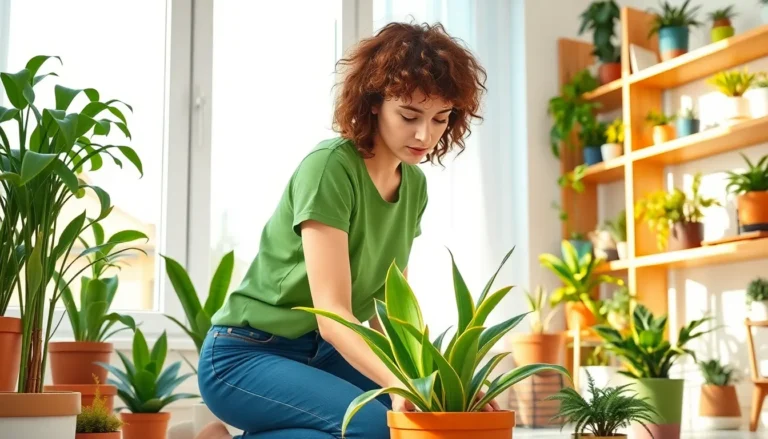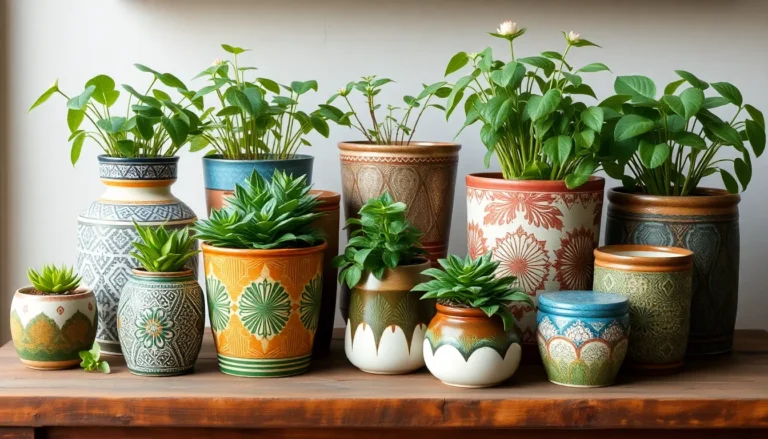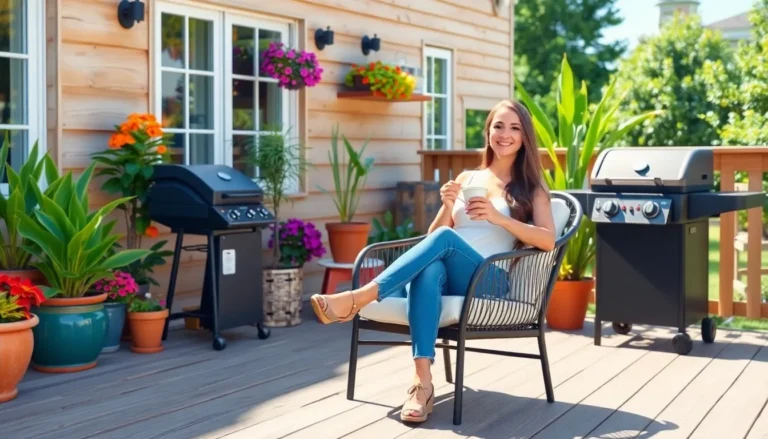Imagine transforming your home into a lush oasis without ever leaving your couch. Green leaf house plants are the unsung heroes of interior design, effortlessly bringing life and vibrancy to any space. Not only do they purify the air, but they also offer a delightful excuse to show off your plant-parenting skills. Who wouldn’t want to impress guests with a thriving monstera or a charming pothos?
Table of Contents
ToggleOverview of Green Leaf House Plants
Green leaf house plants encompass a wide variety of species known for their lush, vibrant foliage. These plants, such as pothos, monstera, and snake plants, thrive indoors and contribute to a refreshing atmosphere. They improve indoor air quality by absorbing toxins and releasing oxygen, promoting overall well-being.
Many green leaf plants exhibit low maintenance requirements, making them ideal for busy individuals. Some, like peace lilies, signal their water needs with drooping leaves, providing an easy care guide. Others, including ficus and ZZ plants, adapt to different light conditions, enhancing their versatility in home settings.
Aesthetic appeal plays a crucial role in the selection of green leaf plants. Their varying shades of green and unique leaf patterns create visual interest in any room. Incorporating these plants into home decor can transform spaces, adding warmth and depth.
Green leaf house plants also foster a sense of accomplishment for plant enthusiasts. Successfully nurturing a variety of greens showcases one’s horticultural skills and provides an avenue for personal expression. Whether placed on shelves, windowsills, or tabletops, these plants bring joy and life into everyday environments.
Understanding the benefits of these plants emphasizes their importance in modern interiors. Homeowners gain more than just decoration; they invest in healthier living conditions. Overall, the richness of green leaf house plants enhances any space while contributing positively to mental and physical health.
Benefits of Green Leaf House Plants
Green leaf house plants offer numerous advantages beyond aesthetics. These plants contribute positively to indoor environments through various benefits.
Air Purification
Air quality improves significantly with green leaf house plants. Plants like peace lilies, pothos, and snake plants absorb harmful toxins like formaldehyde and benzene. In fact, NASA’s Clean Air Study found these plants can remove up to 87% of indoor pollutants. By releasing oxygen during photosynthesis, they promote a healthier living space. Incorporating a few strategically placed plants can enhance air quality and lead to a fresher atmosphere.
Aesthetic Appeal
Visual interest spikes when green leaf house plants enter a room. Diverse shades of green and intricate leaf patterns captivate the eye, creating a lively environment. Plants such as monstera and fiddle-leaf figs can serve as striking focal points. Positioning these plants near natural light sources boosts their beauty and vitality. Selection varies based on personal taste, accommodating various interior styles while enhancing overall decor.
Stress Reduction
Biophilia plays an essential role in reducing stress with green leaf house plants. The presence of plants lowers anxiety levels and enhances mood. Research indicates that spending time around plants can improve focus and boost creativity. Implementing plants in home or office settings fosters tranquility, making spaces more inviting. With regular care, the act of nurturing plants also creates a soothing routine, further contributing to well-being.
Popular Types of Green Leaf House Plants
Green leaf house plants offer a variety of options to enhance indoor spaces. Here are some popular types that stand out for their beauty and benefits.
Snake Plant
Snake plants are renowned for their striking upright leaves that can grow up to 4 feet tall. Low maintenance makes them ideal for neglectful owners; they thrive in indirect light and require minimal watering. This plant absorbs toxins like formaldehyde and benzene, contributing to better air quality. It tolerates various conditions, including drought, showcasing its resilience.
Pothos
Pothos plants are favored for their trailing vines and heart-shaped leaves, creating a lush aesthetic. They adapt well to most lighting, though bright, indirect light promotes growth. Occasional watering suffices, as they signal thirst by drooping leaves. Pothos effectively purifies air by removing indoor pollutants, making it a great choice for improving indoor environments.
Fiddle Leaf Fig
Fiddle leaf figs command attention with their large, glossy leaves that can grow up to 18 inches long. These plants prefer bright, filtered light and like a consistent watering schedule, allowing the topsoil to dry between waterings. Their dramatic presence and height, reaching up to 10 feet indoors, make them a popular statement piece. Regular dusting of leaves is essential to maintain their health and vibrancy.
ZZ Plant
ZZ plants are celebrated for their glossy, dark green leaves that add elegance to any room. They thrive in low light and tolerate infrequent watering, making them nearly indestructible. The plant’s unique growth habit features thick stems that store water, allowing it to survive extended dry periods. ZZ plants also contribute to indoor air quality, helping eliminate toxins effectively.
Care Tips for Green Leaf House Plants
Green leaf house plants require specific care to thrive and enhance indoor spaces effectively. Following a few essential guidelines ensures healthy growth.
Light Requirements
Bright, indirect light suits many green leaf house plants like pothos and monstera. Some plants, including snake plants, tolerate low-light conditions. Filtering sunlight through sheer curtains or placing plants near east-facing windows promotes optimal growth. Avoid harsh, direct sunlight, which can scorch leaves. Observing a plant’s reaction to light can guide adjustments; if leaves start to yellow or drop, consider changing the plant’s location.
Watering Guidelines
Consistent watering promotes vitality in green leaf house plants. Most plants prefer to dry out slightly between waterings, preventing root rot. Checking the top inch of soil provides a simple moisture indicator; if it feels dry, it’s time to water. When watering, do so thoroughly until water drains from the pot’s bottom. Adjust frequency based on seasonal changes, as plants often require less water in winter than in summer.
Soil and Fertilization
Well-draining potting soil ensures root health for green leaf house plants. A mix containing peat moss, perlite, and compost fosters aeration and drainage. Fertilizing every 4 to 6 weeks during the growing season supports nutrient availability. A balanced fertilizer, like 10-10-10, works effectively for most indoor plants. Reducing or skipping fertilization during dormancy in winter aids balanced growth cycles.
Integrating green leaf house plants into home decor enriches both the environment and the spirit. These plants not only beautify spaces but also contribute to a healthier living atmosphere. Their ability to purify air and improve mood makes them essential companions in modern homes.
With various options available, from snake plants to fiddle leaf figs, there’s a perfect plant for every lifestyle. Caring for these vibrant greens can be a rewarding experience that fosters a connection to nature. Embracing green leaf house plants is a simple yet impactful way to enhance interior spaces while promoting well-being.






